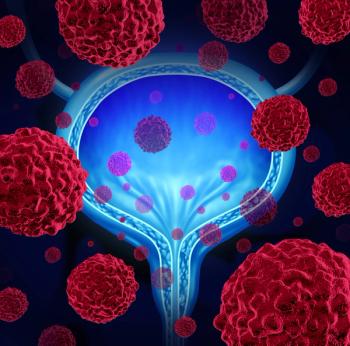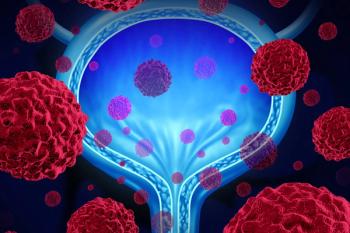
Oncology NEWS International
- Oncology NEWS International Vol 9 No 7
- Volume 9
- Issue 7
Gemcitabine/Cisplatin Said to Offer Less Toxic Alternative to MVAC in Bladder Cance
COPENHAGEN-For patients with locally advanced or metastatic bladder cancer (transitional cell carcinoma of the urothelium), the combination of gemcitabine (Gemzar) and cisplatin (Platinol) may offer a less toxic regimen, according to a presentation at the ASCO meeting.
COPENHAGENFor patients with locally advanced or metastatic bladder cancer (transitional cell carcinoma of the urothelium), the combination of gemcitabine (Gemzar) and cisplatin (Platinol) may offer a less toxic regimen, according to a presentation at the ASCO meeting.
MVAC (methotrexate, vinblastine, Adriamycin, and cisplatin), the only regimen with proven survival benefit for this population, is associated with considerable toxicity, especially neutropenic sepsis and mucositis, according to Hans Von der Maase, MD, Aarhus University Hospital, Copenhagen, Denmark.
Dr. Von der Maase led a phase III multicenter trial in 19 countries (mostly European), following phase II studies demonstrating that the gemcitabine/cisplatin combination is active, safe, and well tolerated.
The primary endpoint of the trial was overall survival and the result was 4-month improvement. Secondary endpoints included response, time to disease progression, time to treatment failure, toxicity, changes in quality of life, and utilization of various medical resources.
No Prior Chemotherapy
None of the 405 patients (median age, 63; 79% male) in the study had prior chemotherapy.
Patients were randomized to receive either gemcitabine/cisplatin (with gemcitabine at 1,000 mg/m² on days 1, 8, and 15, and cisplatin at 70 mg/m² day 2) or MVAC every 28 days, for a maximum of six cycles.
The MVAC regimen consists of 28-day cycles of methotrexate at 30 mg/m² days 1, 15, and 22; vinblastine 3 mg/m² days 2, 15, and 22; Adriamycin 30 mg/m² day 2; and cisplatin 70 mg/m² day 2. As in the other arm of the study, cisplatin was given at 70 mg/m² on day 2.
Eighty-four percent of gemcitabine/cisplatin and 82% of MVAC patients had the bladder as primary tumor site. In addition, 70% of gemcitabine/cisplatin and 64% of MVAC patients had metastatic disease.
After a median follow-up of 19 months, overall survival was 13.8 months in the gemcitabine/cisplatin arm and 14.8 months in the MVAC arm. There were 274 deaths.
Complete responses were reported in 12% of both groups, and partial responses were found in 37% of gemcitabine/cisplatin patients and 34% of MVAC patients, for overall rates of 50% of gemcitabine/cisplatin patients and 46% of MVAC patients.
Time to progressive disease, which occurred among 334 participants, was 7.4 months for both study arms. None of the differences were statistically significant, Dr. Von der Maase said.
Negative prognostic factors included Karnofsky index less than 80, elevated alkaline phosphatase levels, and the presence of rhizome metastases. Adjusting for these factors did not reveal any differences in outcomes, Dr. Von der Maase pointed out.
Toxicity Rates Vary
Grade 3-4 anemia occurred more frequently in the gemcita-bine/cisplatin group (26%) than in the MVAC group (17%), as did thrombocytopenia56% in the gemcitabine/cisplatin group and 21% in the MVAC group. Grade 3-4 neutropenia, however, occurred more often in the MVAC group (82%) than in the gemcitabine group (71%). In the MVAC group, 65% of neutropenia cases were grade 4.
More importantly, Dr. Von der Maase said, we should look not at the lab values, but at the hematologic complications.
He pointed out that hemorrhage rates were the same for both arms at 2%, but neutropenic fever was reported in 5% of gemcitabine patients and in 22% of MVAC patients. Also, neutropenic sepsis was found in 1% of gemcitabine patients and 12% of MVAC patients. Toxic death rates were 1% and 3%, respectively.
Nonhematologic toxicities were more common for MVAC, Dr. Von der Maase said. The infection rate was 2.5% for gemcita-bine vs 15% for MVAC; mucositis 1% vs 22%; diarrhea 3% vs 7.5%; and alopecia 11% vs 55%. There were no differences in nausea and vomiting and other toxicity parameters.
While improvements in emotional function and pain were noted in both arms, and quality of life, in general, was maintained, fatigue scores worsened in the MVAC arm.
Medical resource utilization was higher for MVAC with increases in need for G-CSF (Neupogen), antifungals, antivirals, and antibiotics. Need for transfusions was slightly higher with gemcitabine/cisplatin.
Most striking was the increase in admissions in the MVAC group for neutropenic fever49 admissions, totaling 272 days. For the gemcitabine group, there were only 9 admissions, for a total of 33 days.
Positive or Negative Result?
Dr. Von der Maase concluded that efficacy was similar between treatment arms, but that toxicities were higher for MVAC. The risk-benefit profile in this large randomized trial support the use of the combination of gemcitabine and cisplatin as a new standard in patients with locally advanced and/or metastatic transitional cell carcinoma of the urethelium.
Following Dr. Von der Maases presentation, some objections were raised over considering the trials outcomes to be sufficient to merit proclaiming a new standard of practice. It was pointed out that the trials primary objective was, indeed, survival benefit, making the trial a negative one.
Dr. Von der Maase replied, I consider it a positive trial regarding toxicity.
The objection was also raised that G-CSF was not given routinely to MVAC patients, which might have accounted for the increased toxicities.
Howard Scher, MD, Memorial Sloan-Kettering Cancer Center, the ASCO session discussant, reviewed the positive aspects of the trial and the objections noted above and concluded, My own bias is toward the former, that if a regimen is easier and appears to be similar in terms of survival it should at least be offered as an alternative.
He added, however, There is really no cause for celebration. We have made no impact on survival time.
Articles in this issue
over 25 years ago
Couric Urges Doctors to Talk to Patients About Colon Cancerover 25 years ago
Automated Imaging Notification System Close to Fail-Safeover 25 years ago
Higher Dairy Consumption Linked to Prostate Cancer Riskover 25 years ago
First-Year Funding of Early Detection Research Network Completeover 25 years ago
Gritty Antitobacco Ads and More From Legacy Foundationover 25 years ago
Tositumomab Effective for Low-Grade Follicular Lymphomaover 25 years ago
New Awards Spotlight Courage of Cancer Survivorsover 25 years ago
Hospital Volume Shown to Predict Breast Cancer Outcomeover 25 years ago
New Drug Information Websiteover 25 years ago
NCCN Presents Updated Colorectal Cancer GuidelinesNewsletter
Stay up to date on recent advances in the multidisciplinary approach to cancer.















































































